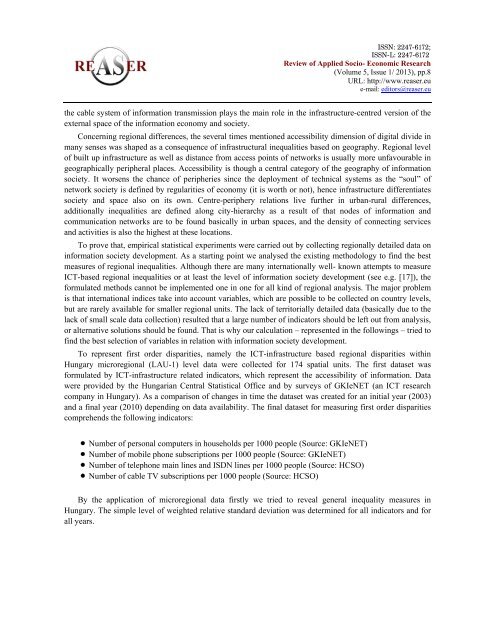new characteristics of inequalities in the information society and ...
new characteristics of inequalities in the information society and ...
new characteristics of inequalities in the information society and ...
Create successful ePaper yourself
Turn your PDF publications into a flip-book with our unique Google optimized e-Paper software.
ISSN: 2247-6172;<br />
ISSN-L: 2247-6172<br />
Review <strong>of</strong> Applied Socio- Economic Research<br />
(Volume 5, Issue 1/ 2013), pp.8<br />
URL: http://www.reaser.eu<br />
e-mail: editors@reaser.eu<br />
<strong>the</strong> cable system <strong>of</strong> <strong>in</strong>formation transmission plays <strong>the</strong> ma<strong>in</strong> role <strong>in</strong> <strong>the</strong> <strong>in</strong>frastructure-centred version <strong>of</strong> <strong>the</strong><br />
external space <strong>of</strong> <strong>the</strong> <strong>in</strong>formation economy <strong>and</strong> <strong>society</strong>.<br />
Concern<strong>in</strong>g regional differences, <strong>the</strong> several times mentioned accessibility dimension <strong>of</strong> digital divide <strong>in</strong><br />
many senses was shaped as a consequence <strong>of</strong> <strong>in</strong>frastructural <strong><strong>in</strong>equalities</strong> based on geography. Regional level<br />
<strong>of</strong> built up <strong>in</strong>frastructure as well as distance from access po<strong>in</strong>ts <strong>of</strong> networks is usually more unfavourable <strong>in</strong><br />
geographically peripheral places. Accessibility is though a central category <strong>of</strong> <strong>the</strong> geography <strong>of</strong> <strong>in</strong>formation<br />
<strong>society</strong>. It worsens <strong>the</strong> chance <strong>of</strong> peripheries s<strong>in</strong>ce <strong>the</strong> deployment <strong>of</strong> technical systems as <strong>the</strong> “soul” <strong>of</strong><br />
network <strong>society</strong> is def<strong>in</strong>ed by regularities <strong>of</strong> economy (it is worth or not), hence <strong>in</strong>frastructure differentiates<br />
<strong>society</strong> <strong>and</strong> space also on its own. Centre-periphery relations live fur<strong>the</strong>r <strong>in</strong> urban-rural differences,<br />
additionally <strong><strong>in</strong>equalities</strong> are def<strong>in</strong>ed along city-hierarchy as a result <strong>of</strong> that nodes <strong>of</strong> <strong>in</strong>formation <strong>and</strong><br />
communication networks are to be found basically <strong>in</strong> urban spaces, <strong>and</strong> <strong>the</strong> density <strong>of</strong> connect<strong>in</strong>g services<br />
<strong>and</strong> activities is also <strong>the</strong> highest at <strong>the</strong>se locations.<br />
To prove that, empirical statistical experiments were carried out by collect<strong>in</strong>g regionally detailed data on<br />
<strong>in</strong>formation <strong>society</strong> development. As a start<strong>in</strong>g po<strong>in</strong>t we analysed <strong>the</strong> exist<strong>in</strong>g methodology to f<strong>in</strong>d <strong>the</strong> best<br />
measures <strong>of</strong> regional <strong><strong>in</strong>equalities</strong>. Although <strong>the</strong>re are many <strong>in</strong>ternationally well- known attempts to measure<br />
ICT-based regional <strong><strong>in</strong>equalities</strong> or at least <strong>the</strong> level <strong>of</strong> <strong>in</strong>formation <strong>society</strong> development (see e.g. [17]), <strong>the</strong><br />
formulated methods cannot be implemented one <strong>in</strong> one for all k<strong>in</strong>d <strong>of</strong> regional analysis. The major problem<br />
is that <strong>in</strong>ternational <strong>in</strong>dices take <strong>in</strong>to account variables, which are possible to be collected on country levels,<br />
but are rarely available for smaller regional units. The lack <strong>of</strong> territorially detailed data (basically due to <strong>the</strong><br />
lack <strong>of</strong> small scale data collection) resulted that a large number <strong>of</strong> <strong>in</strong>dicators should be left out from analysis,<br />
or alternative solutions should be found. That is why our calculation – represented <strong>in</strong> <strong>the</strong> follow<strong>in</strong>gs – tried to<br />
f<strong>in</strong>d <strong>the</strong> best selection <strong>of</strong> variables <strong>in</strong> relation with <strong>in</strong>formation <strong>society</strong> development.<br />
To represent first order disparities, namely <strong>the</strong> ICT-<strong>in</strong>frastructure based regional disparities with<strong>in</strong><br />
Hungary microregional (LAU-1) level data were collected for 174 spatial units. The first dataset was<br />
formulated by ICT-<strong>in</strong>frastructure related <strong>in</strong>dicators, which represent <strong>the</strong> accessibility <strong>of</strong> <strong>in</strong>formation. Data<br />
were provided by <strong>the</strong> Hungarian Central Statistical Office <strong>and</strong> by surveys <strong>of</strong> GKIeNET (an ICT research<br />
company <strong>in</strong> Hungary). As a comparison <strong>of</strong> changes <strong>in</strong> time <strong>the</strong> dataset was created for an <strong>in</strong>itial year (2003)<br />
<strong>and</strong> a f<strong>in</strong>al year (2010) depend<strong>in</strong>g on data availability. The f<strong>in</strong>al dataset for measur<strong>in</strong>g first order disparities<br />
comprehends <strong>the</strong> follow<strong>in</strong>g <strong>in</strong>dicators:<br />
Number <strong>of</strong> personal computers <strong>in</strong> households per 1000 people (Source: GKIeNET)<br />
Number <strong>of</strong> mobile phone subscriptions per 1000 people (Source: GKIeNET)<br />
Number <strong>of</strong> telephone ma<strong>in</strong> l<strong>in</strong>es <strong>and</strong> ISDN l<strong>in</strong>es per 1000 people (Source: HCSO)<br />
Number <strong>of</strong> cable TV subscriptions per 1000 people (Source: HCSO)<br />
By <strong>the</strong> application <strong>of</strong> microregional data firstly we tried to reveal general <strong>in</strong>equality measures <strong>in</strong><br />
Hungary. The simple level <strong>of</strong> weighted relative st<strong>and</strong>ard deviation was determ<strong>in</strong>ed for all <strong>in</strong>dicators <strong>and</strong> for<br />
all years.








